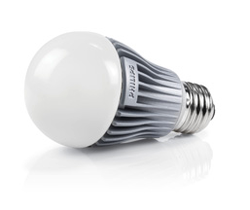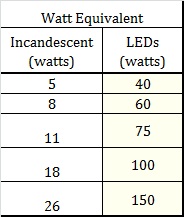
Federal energy initiatives push to inform the public on different lighting options for their homes and businesses. The recent implementation of the Lighting Facts product label is possibly the epitome of this energy efficient lighting movement, as lawmakers continue to try to outlaw incandescent light bulbs. One of the most important metrics on the Lighting Facts label is brightness. Appropriately listed first on the lighting facts label, its purpose is to guide the consumers to making the correct purchase for their home based on sound principles.
For years, homeowners bought light bulbs based on their watt rating; with the understanding that the more watts that the light bulb was rated, the brighter it would be. The truth is the relationship between watts and brightness of light output is rather indirect. A watt is a unit of power, or energy consumed by the light source. A watt rating, as indicated on the traditional incandescent light bulb and on the lighting facts label, represents the amount of watts consumed by the light bulb in one hour of use. If consumers want to buy a light bulb that will emit a certain level of brightness, then they should buy a light bulb based on its rating of lumens.
For years, homeowners bought light bulbs based on their watt rating; with the understanding that the more watts that the light bulb was rated, the brighter it would be. The truth is the relationship between watts and brightness of light output is rather indirect. A watt is a unit of power, or energy consumed by the light source. A watt rating, as indicated on the traditional incandescent light bulb and on the lighting facts label, represents the amount of watts consumed by the light bulb in one hour of use. If consumers want to buy a light bulb that will emit a certain level of brightness, then they should buy a light bulb based on its rating of lumens.
With so many alternative lighting options available today and the anticipated incandescent lighting ban, consumers must become familiar with basing their lighting decisions on lumens. The most common lighting alternatives to traditional incandescent lighting are compact fluorescent light (CFL) and light emitting diode (LED) light bulbs. These forms of lighting technology actually use fewer watts (power) to produce equivalent amounts of lumens (brightness) as compared to incandescent light bulbs. This is the lighting watt paradox. A light bulb that uses fewer watts should be more desirable as long as it produces a sufficient amount of lumens. This relationship fundamentally describes energy efficient lighting.
A light bulb that produces more lumens using fewer watts is more energy efficient. Mathematically, the proportion of lumens to watts consumed is actually an industry standard measurement referred to as a light bulb’s efficacy.
Many building codes and regulations of energy efficiency have adopted this metric to mandate that homeowners and business owners maintain certain levels of efficacy by their normally operating lights.
Once incandescent lights are no longer on the shelves of America’s favorite retail stores, consumers will be forced to recognize the lighting watt paradox. This unfortunately popular misunderstanding will then be phased out with the
incandescent lights themselves, and light bulbs will be appropriately compared on the basis of lumens. Since incandescent lights consistently produce proportional brightness to watts burned, this table can help transition the thought process from watts to lumens.
A light bulb that produces more lumens using fewer watts is more energy efficient. Mathematically, the proportion of lumens to watts consumed is actually an industry standard measurement referred to as a light bulb’s efficacy.
Many building codes and regulations of energy efficiency have adopted this metric to mandate that homeowners and business owners maintain certain levels of efficacy by their normally operating lights.
Once incandescent lights are no longer on the shelves of America’s favorite retail stores, consumers will be forced to recognize the lighting watt paradox. This unfortunately popular misunderstanding will then be phased out with the
incandescent lights themselves, and light bulbs will be appropriately compared on the basis of lumens. Since incandescent lights consistently produce proportional brightness to watts burned, this table can help transition the thought process from watts to lumens.

 RSS Feed
RSS Feed